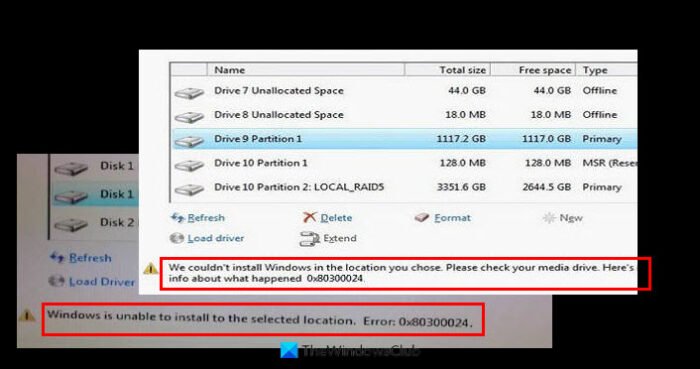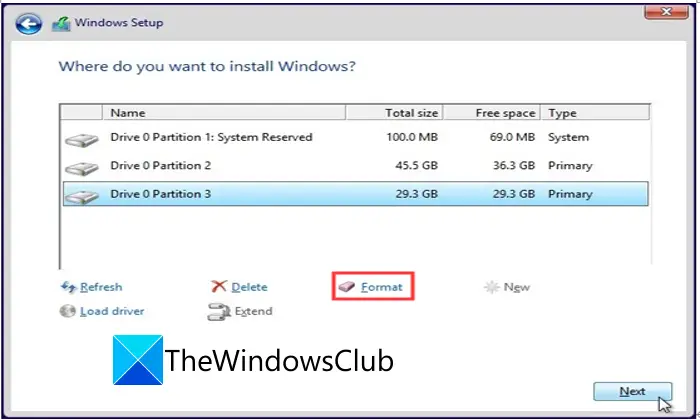Are you getting an error code 0x80300024 when trying to install Windows on your computer? Here is a complete guide to getting rid of Windows installation error code 0x80300024. Some users have faced the error code 0x80300024 when they were trying to install a newer or a different version of Windows on their computers. When triggered, the error code prompts the following error message:
Windows is unable to install to the selected location, Error 0x80300024
OR
We couldn’t install Windows in the location you chose. Please check your media drive, Error 0x80300024.

This error code basically indicates a problem with the target disk, partition, or volume where you are trying to install Windows. Now, if you are experiencing the same error code and are clueless on how you can get rid of it, this guide is for you. Here, we are going to discuss several working fixes that reportedly resolved the problem for affected users.
Do note that before trying out any solutions, make sure your PC meets the minimum requirements to install a particular version of Windows on your system.
What causes error 0x80300024 when installing Windows?
After analyzing the user reports, here are some possible causes that may trigger the error code 0x80300024 when installing Windows:
- It can be caused if you have too many unnecessary hard drives are plugged into your system. So, before proceeding with Windows installation, remove extra hard drives.
- This error may trigger if there is not enough space on the disk partition you are trying to install Windows on. So, consider making enough disk space on disk partition to install Windows if the scenario applies.
- In case your disk partition contains errors or corruption, it might cause this error. In that case, you can use the DiskPart tool to fix the corruption.
- A corrupted hard drive can be another reason for this error. If nothing works, you might have to replace your hard drive with a new one.
Now that you know the scenarios that cause this error, let us get straight to the solutions.
How to Fix Error 0x80300024 when Installing Windows 11/10
Here are the methods you can try to fix error code 0x80300024 encountered when installing Windows 11/10:
- Unplug unnecessary hard drives.
- Check with a different USB port.
- Ensure that the Boot Order is Correct.
- Format the installation device.
- Get Enough Disk Space.
- Use DiskPart.
- Replace your hard drive.
1] Unplug unnecessary hard drives
The error can be triggered if there are multiple unnecessary hard drives connected to your system. The extra hard drives might be interfering with the installation process and thus cause the error code 0x80300024. If the scenario is applicable, remove all the unnecessary hard drives on which you don’t wish to install Windows. After unplugging additional hard drives, retry the installation and then check if the error is fixed.
If the scenario doesn’t apply to your or you still get the same error after removing unnecessary hard drives, you can move on to the next potential fix to resolve the error.
See: Windows cannot install required files
2] Check with a different USB port
If you are trying to install Windows using installation media (USB) and getting the same error, the problem might be with the port you are using. You can try changing the USB port to plug in your installation media and then re-attempt to install Windows on our system. So, let’s say you are currently using a USB 2.0 port for your installation media, then switch to a USB 3.0 port to resolve the error. And, vice-versa.
This is one of the most effective solutions as per user reports. So, try your luck with this method and see if it fixes the error for you.
Read: Access is Denied error while installing software on Windows
3] Ensure that the Boot Order is Correct
This error might be triggered in case the hard drive on which you are installing Windows is not at the top of your system’s boot order. In that case, you can try changing the boot order making sure that the target drive is at the top of the computer’s boot order. Here are the steps to do that:
- Firstly, start your PC.
- When the computer starts booting, on the first screen, you will see instructions to press a specific key to enter BIOS/ Setup. In most cases, the keys are Delete, F1, or F2. You can tap on the specified key to enter the BIOS.
- Now, on the BIOS screen, locate and navigate to your computer’s boot order/configuration. Most likely, you will find the boot order under the BIOS’s Boot tab.
- Next, you need to adjust the boot order such as the hard drive on which you are trying to install Windows is at the top.
- After that, you also need to make sure that you have chosen “UEFI” as the boot mode.
- Finally, save changes and exit the BIOS setup.
Once the system reboots, try Windows installation again and see whether the error is gone.
4] Format the installation device

If the hard-drive partition on which you are trying to install Windows was in use before and contains corruption or some data that might be interfering with the installation of Windows, it might trigger this error. In that case, you can try formatting the location before you try to install Windows on your system. However, before doing that, do create a backup of your important data.
Here are the steps to format the installation location on your PC:
- First of all, insert the bootable installation media into your PC and then reboot it. You can create an installation media in case you don’t already have it.
- While the PC is starting up, select to boot from the plugged-in installation media.
- Now, you can set up your language, keyboard layout, and other preferences.
- Next, press the Custom option when you are asked what kind of Windows installation you wish.
- After that, click on Drive options (advanced) when prompted on where you want Windows to be installed.
- Then, select the hard drive partition where you want to install Windows, and then press the Format button and confirm the process.
- When the formatting process is finished, click on the Next button to continue the installation.
See if the error is now resolved. If not, move on to the next fix to resolve the error.
5] Get Enough Disk Space
If the hard-drive partition you are trying to install Windows on doesn’t have sufficient space to install Windows, you can try making some more space on the disk. You can try freeing up some space by deleting unnecessary files from the partition. Alternately, you can also resize or extend the partition to get enough disk space to continue with Windows installation. After doing so, check whether you are able to install Windows without any error.
6] Use DiskPart
In case partition tables of the hard drive contain some corruption, this error might be triggered. If the scenario applies, you can use Windows inbuilt utility called DiskPart to fix the errors. To do that, here are the steps to use:
Firstly, open the command prompt as an administrator.
Now, type the below command one by one and press Enter:
diskpart list disk
Next, from the listed partitions, identify the disk partition number where you are trying to install Windows. Based on the partition number, type and enter a command like the below one:
Select Disk 1
In the above command, replace 1 with the appropriate disk partition number.
After that, type the following command and press Enter:
Clean
Check if the issue is now fixed or not.
7] Replace your hard drive
If nothing works for you, the last resort is to replace your hard drive. The error might be caused due to a dying or dead hard drive as it can prevent you from installing Windows. So, to get rid of the error code 0x80300024, get a new hard drive.
Related: We couldn’t install Windows in the location you choose, 0x80300002.
How do I fix error code 0x80070017?
The error code 0x80070017 may trigger during the process of installation, update, or system restore. To resolve this error code, you can try creating Windows 10 ISO media again, run Microsoft’s Online Troubleshooter, run Windows Update Troubleshooter, or delete files from the SoftwareDistribution folder. In case you get the same error while performing a system restore, you can reset the repository, start Windows in Safe Mode, or reset Windows. Here is a full guide to resolving error code 0x80070017.
Why won’t Windows install on my SSD?
If you are unable to install Windows on your SSD, there might be some problems with the drive or drive partition. It might be containing some errors and corruption that are preventing you from installing Windows on SSD. Or, the drive might not have enough free space to install Windows. You can fix this problem by making sure that SSD is attached correctly and ensuring that you have the latest BIOS version. Other than that, you can try converting the disk to GPT and updating BIOS.
That’s it!
Now read: Fix Select the driver to install error during Windows Installation.